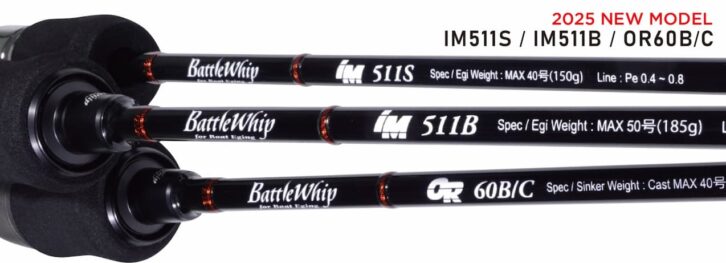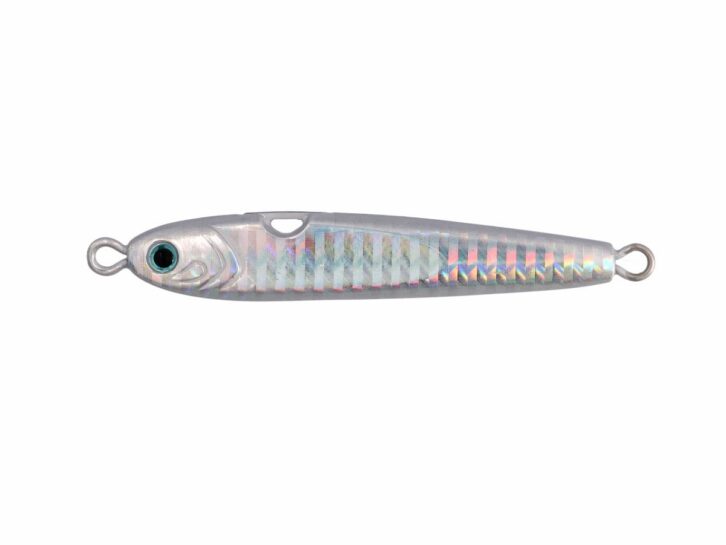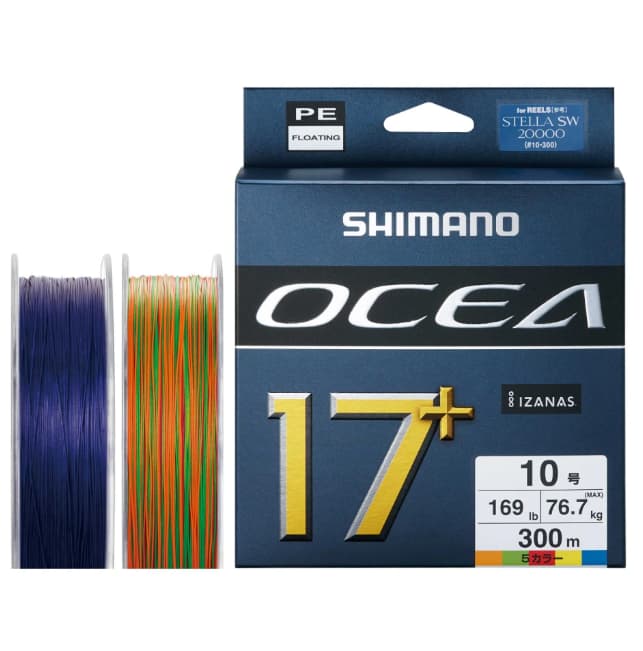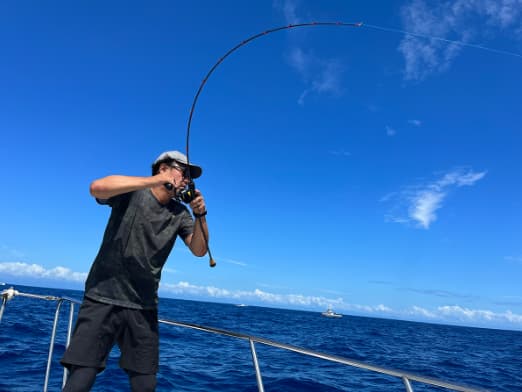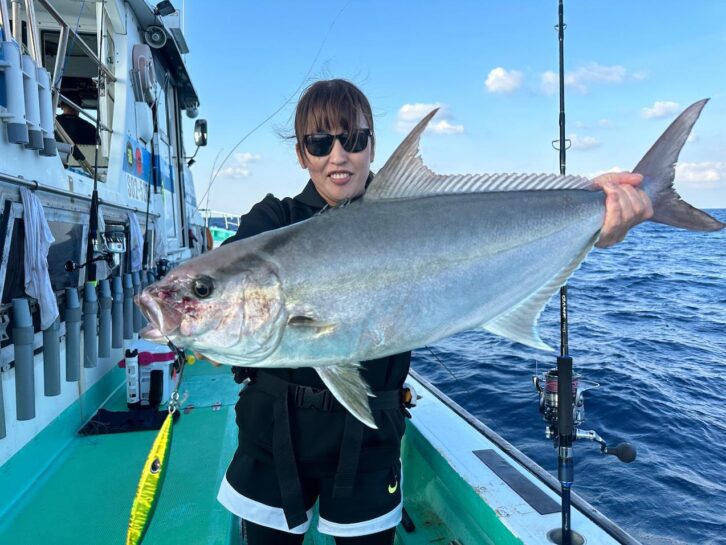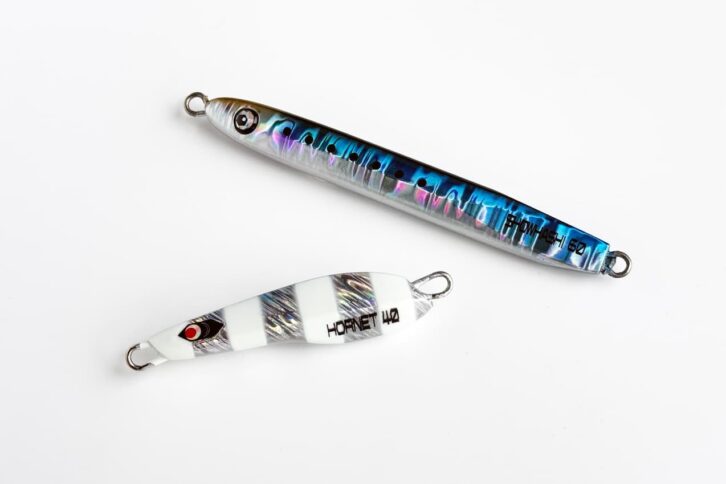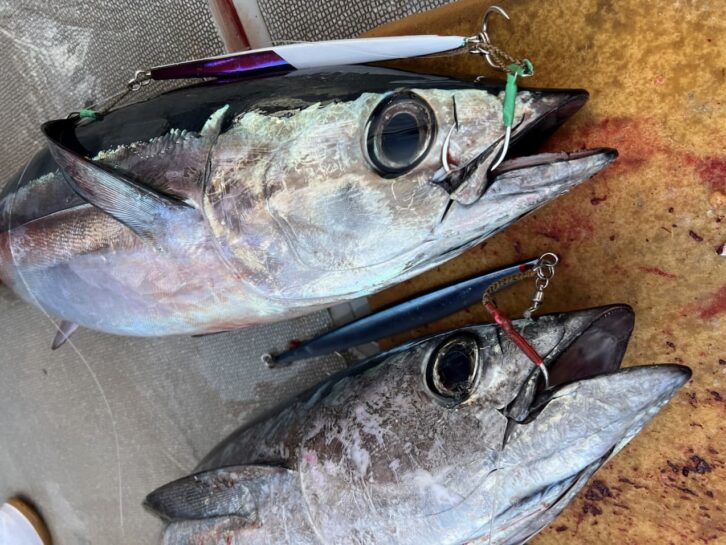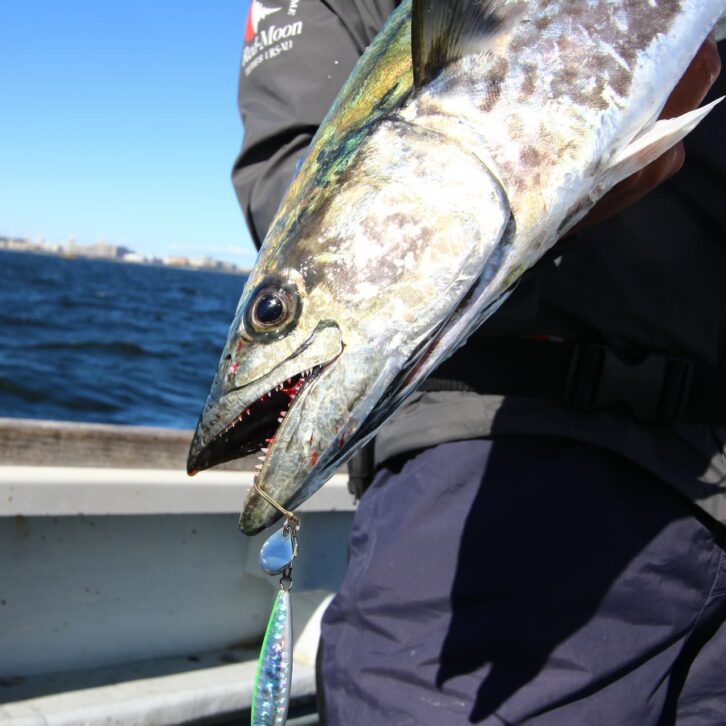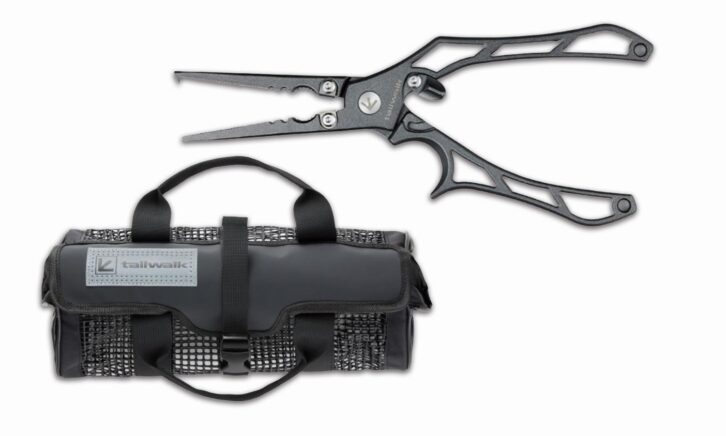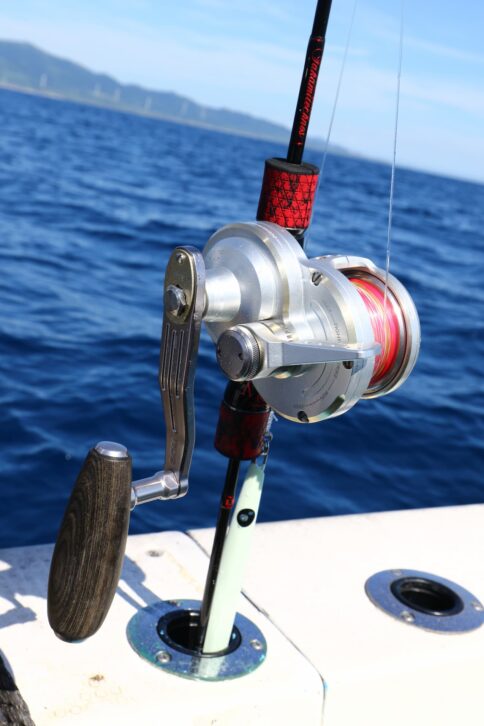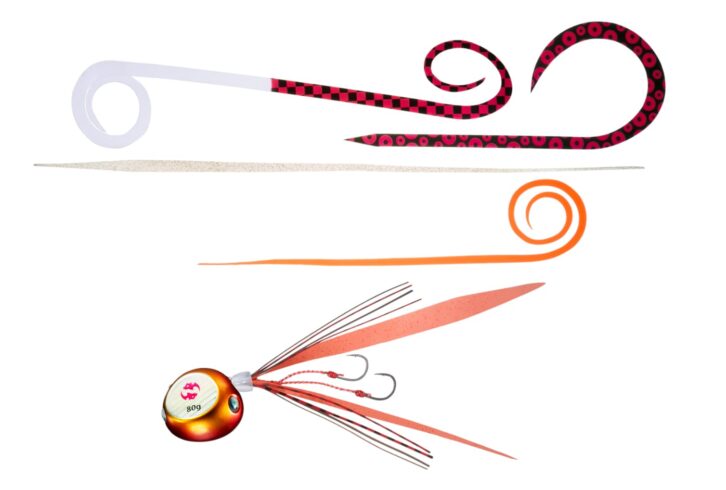Embodying the developer's own weapon of choice
Makoto Ono x JIGRIP start-up! Jig for bluefish ‘Amberjack’. Kumejima test fishing trip
JIGRIP is a fishing tackle manufacturer launched by Makoto Ono, who conveys the fun and depth of jigging through the fishing media. The company plans to introduce a variety of jigging items in the future, and has started developing a jig for bluefish, the most familiar target among them. The name of the jig is ‘SHIOU’. We took the first prototype to Kume Island in the summer of 2024 to target yellowfin tuna, and would like to report on the fishing trip with an explanation of the new jig.
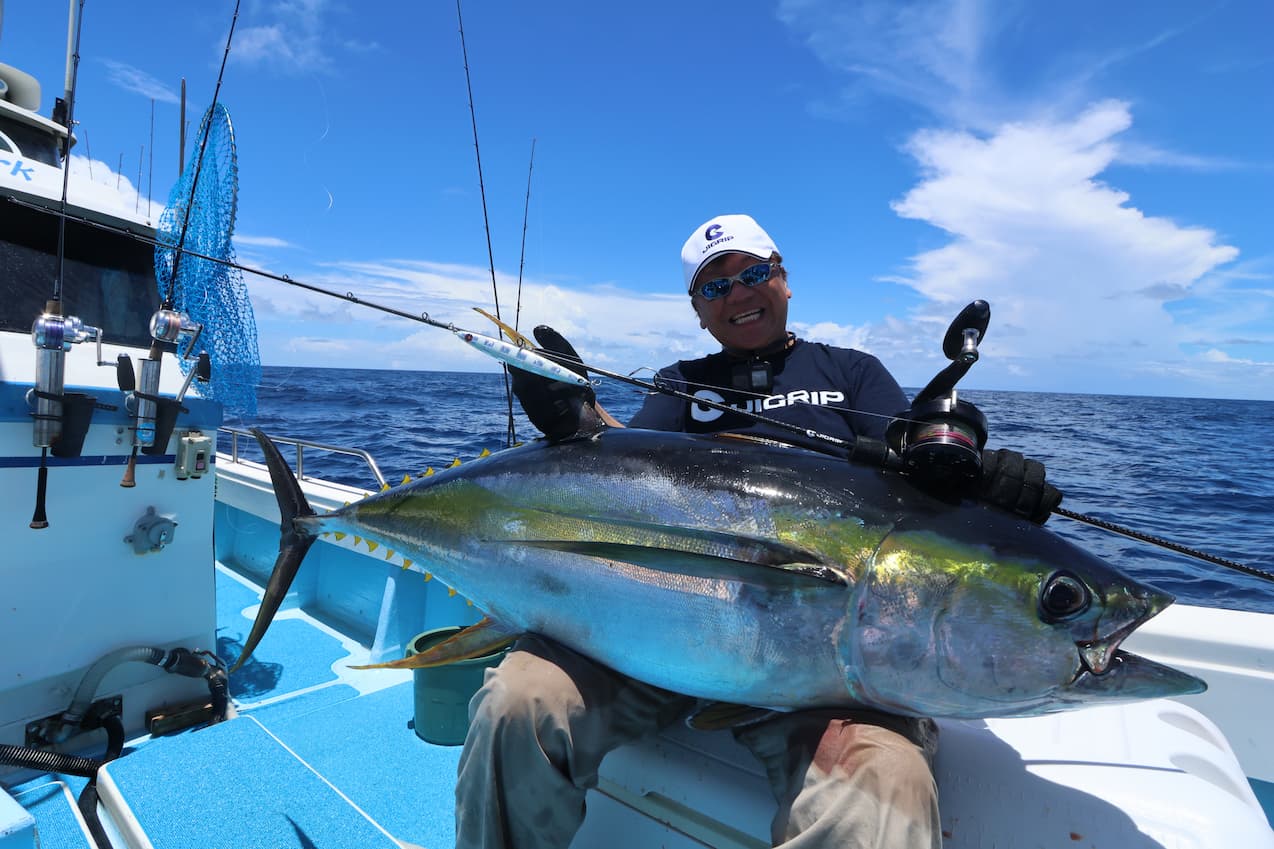
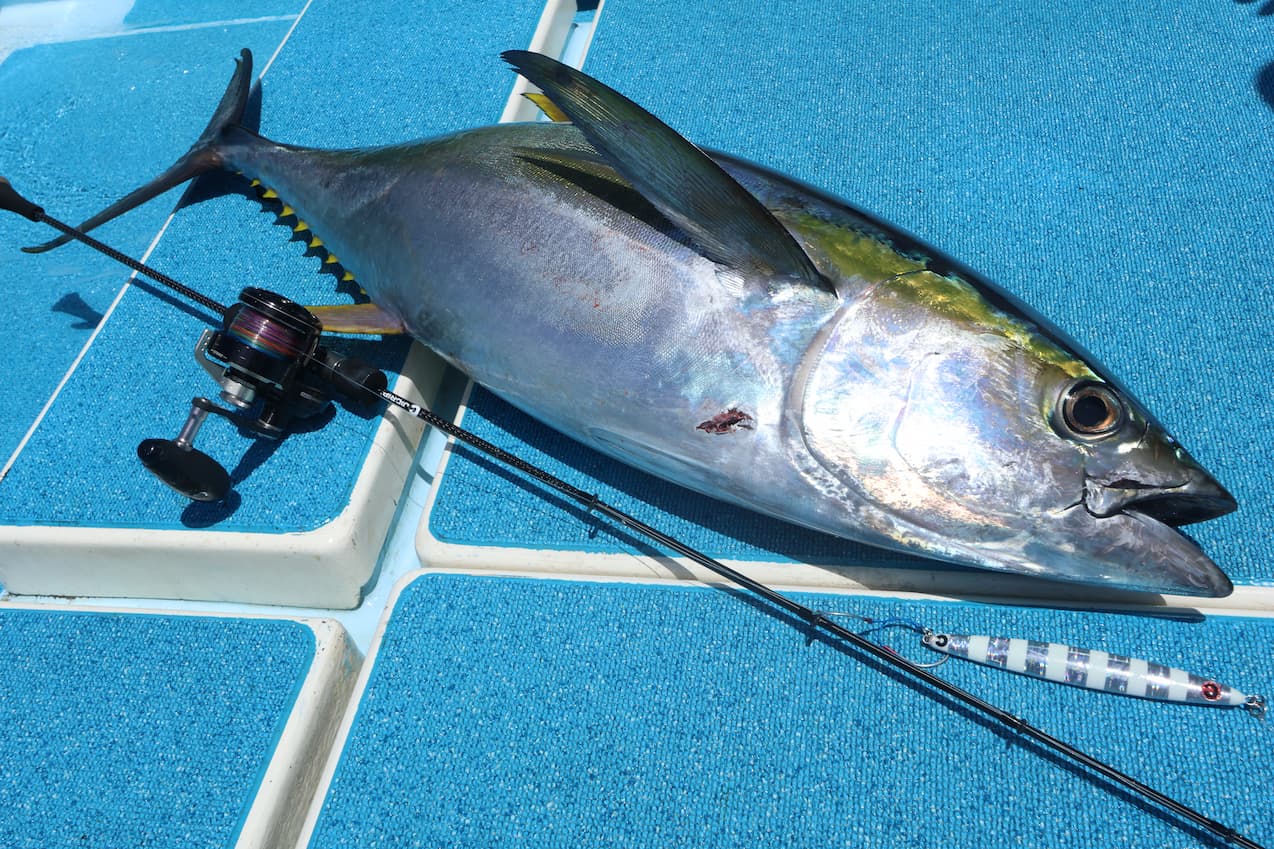
INDEX
Makoto Ono’s jig development. Starting with the cherry salmon jig.
Makoto Ono has been pursuing various types of jigging for many years. He is an expert in the development of fishing tackle and has been active in the fishing media with his fishing tackle. In February 2024, he launched a new manufacturer, JIGRIP. The company is developing fishing tackle that is easy to use for many anglers and that will produce good fishing results, making use of Ono’s past experience. The story is slightly diverted from this Kumejima fishing trip, but the first jig JIGRIP started developing after opening its doors was the AMENOUO jig. It was a jig specially designed for cherry salmon jigging.
The AMENOUO is the result of Mr Ono’s enthusiasm for jigging for cherry salmon over the past few years, and the jig he had in mind after making some discoveries during fishing trips. The jig was then developed and tested in Hokkaido and the Tohoku region.
The jig was designed to be used for jigging, but it was not designed to be used for cherry trout. Then I had been thinking for some time about what kind of jig movements cherry salmon would respond to. We first considered the movement of the jig, and then the rod and the way it is reeled. I wondered if there was any rule of thumb for the cherry salmon bite. So I frequently lost fishing to rear-balanced jigs. Jigging for cherry salmon is often a pattern of moving the jig in one pitch and luring them in with a long fall, but I found that the fall movement was important. When I was using a centre-balanced jig, if I let the jig fall under tension with the line taut after the jerk, the jig would enter cleanly from the tail, but if I let it fall as it was, the fall would be a stalled fall with a wobbly motion. The cherry salmon respond well to the tension fall, but the cherry salmon do not respond well to the stall fall. That’s why we worked on the AMENOUO, the first jig in the JIGRIP range, with a rear-balanced design. A clean and quick fall movement from the rear can be produced with a tension fall even with a centre-balanced jig, but it is difficult to produce it reliably and cleanly every time due to waves and boat turbulence. So we made adjustments to achieve a performance that falls from the tail and slides quickly at an angle, no matter what input anyone makes. In fact, good results were obtained with this jig on every fishing trip, and consideration turned into conviction. The AMENOUO is such a jig.’
JIGRIP’s first product, the AMENOUO cherry salmon jig, will be available in shops in mid-November 2024. We would like to introduce its performance and effectiveness together with Mr Ono’s cherry salmon jigging again.

As well as his on-the-spot fishing skills as a jigging angler, Mr Makoto Ono of JIGRIP is also notable for his ability to prototype jigging tackle. He makes prototypes of jigs in his workshop at home, including cutting mock-ups himself, moulding rubber moulds, casting lead, heat-transferring holos and even painting them. He even makes the epoxy potting eyes for the brand logo himself. While anglers and creators would normally work separately for a manufacturer, he directly reflects his own sensitivities to the product in the jigs he produces. Leaving it up to others inevitably leads to reticence and compromise. The other creator, Ono, redoes prototypes as many times as necessary until the angler Ono himself is satisfied. As one would expect, he does not have the facilities to make prototypes of hooks and rods at home, but he lives in Banshu, Hyogo Prefecture, where there is a cluster of hook and rod factories known as Banshu Tsurigaki. He frequently goes in and out of the factories to pass on the experience and knowledge he has gained in the field. JIGRIP is based in a location where prototype meetings for jigging hooks and jigging rods can be held directly with factory personnel.
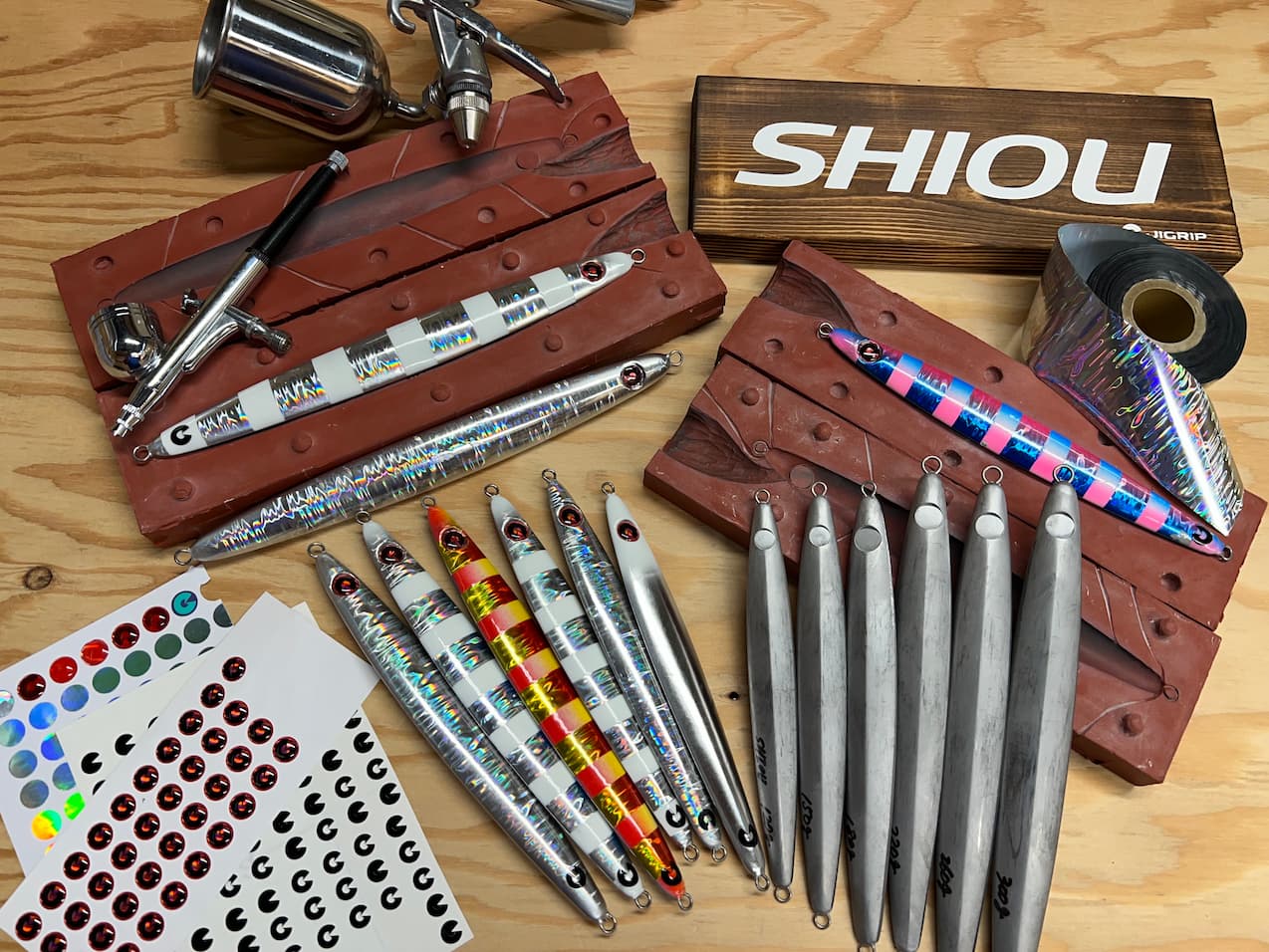
All prototype models of jigs are made by the company itself and shaped to its satisfaction.
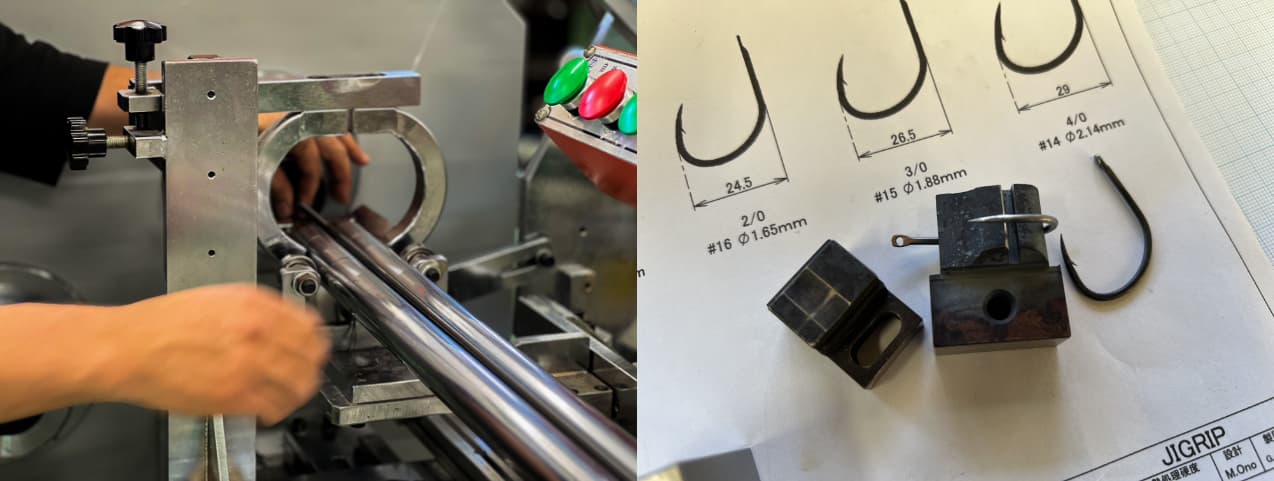
Although it is not possible to produce rod and hook samples at home, there are various fishing-related factories around the town where Ono-san lives. This means that he can have frequent meetings with them and make better products more quickly.
Now back to the subject at hand, the second product he is developing, the ‘SHIOU’ jig for blue-back fish. Mr Ono has jigged for bluefish in a variety of locations, including yellowtail and Spanish mackerel in his home waters off Akashi in Hyogo Prefecture, yellowtail in the Sea of Japan and Seto Inland Sea, and yellowtail in the Genkai Sea, yellowfin tuna off Okinawa and Mie, and kampachi on expeditions. SHIOU is being developed based on this experience. From the sea close at hand to expeditions, the SHIOU is a versatile metal jig with bluefish as its main target. For this reason, Mr Ono says it is ‘a must-have jig for jig manufacturers’.
About the name SHIOU
By the way, this jig is named SHIOU. When we asked Ono about the origin of the name, he told us an interesting story. The first encyclopaedia in Japan, called ‘Wakan Sansai Zue’, was written by the Edo period scholar Terashima Ryoan, and ‘shiou’ appears in the description of fish species. According to the text, it was probably kampachi, but the characters used for ‘shiou’ are interesting. The character for ‘shiou’ is interesting, as it is written ‘ou’, which means ‘king’ in Japanese, following the Japanese amberjack. A scholar from the Edo period described a fish similar to the amberjack in this way. To a fish rarer, larger and more powerful than the amberjack. ‘Siou’ meaning king of the amberjack and the fish. What an exciting character for the modern jigging angler.

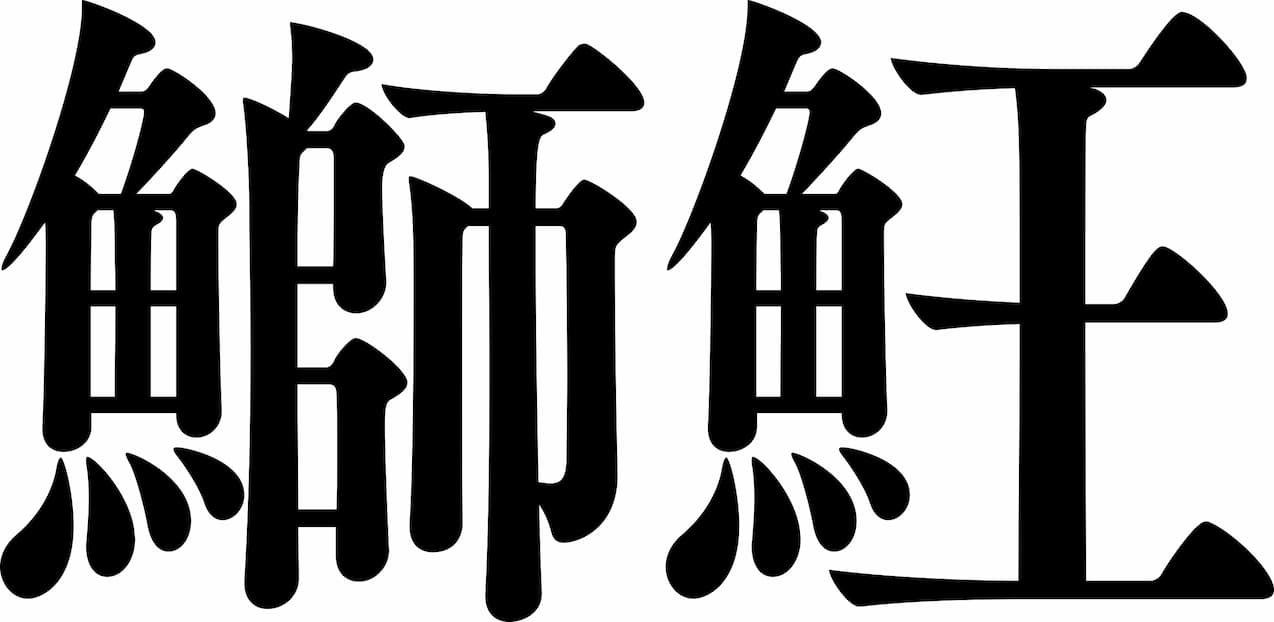
Prototype of SHIOU brought to Kume Island.
The first place we visited for the SHIOU test was Kume Island. Kume Island is a fishing trip that Mr Ono plans every year. Kume Island is famous for yellowfin tuna. It is the place in Japan with the most consistent fishing results. Both jigging and casting are possible, but jigging around the payaos is the most likely way to get bites and catches. Of course, Mr Ono mainly explores by jigging.
The main pattern for jigging yellowfin tuna on Kumejima is to drop the jig quickly to the dana indicated by the captain and search with a slow pitch jerk with a long fall. If no hits are received, the theory is to jerk the jig several times in a single pitch to make its presence known, then change the depths and search again with a larger jerk and fall. The main jig weights are 200-300g. For this reason, Mr Ono has made prototypes of the 240g and 260g SHIOU jigs.
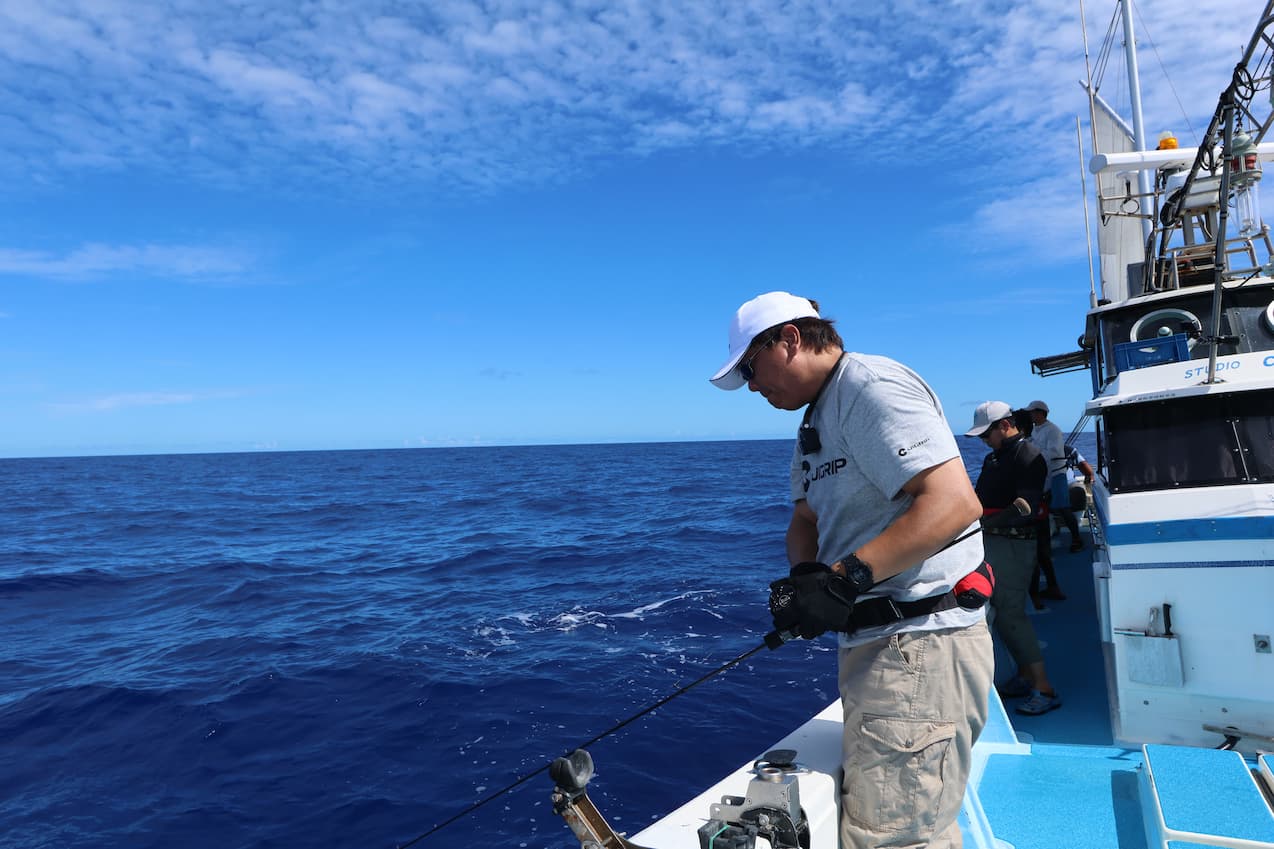
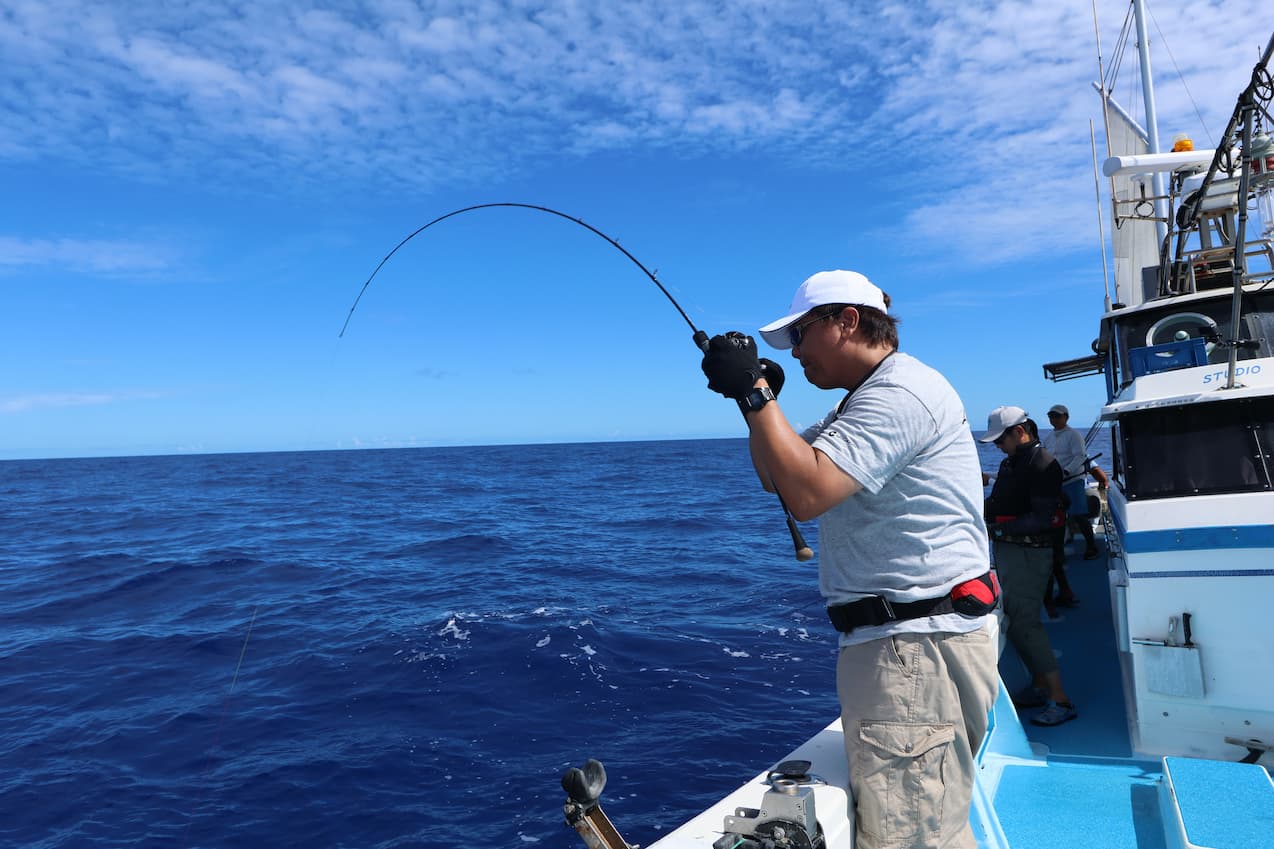
The basic approach to yellowfin jigging on Kume Island is to squish the jig wide and lure the fish with a long fall. What kind of fall movement is best? Anglers adjust the fall movement by squirming and line tension. Depth of water depends on the time, but can range from 70 or 80m to as deep as 240m. Jigs weighing between 200g and 300g are the main rigs used, with 300g or more sometimes being necessary depending on the conditions.
‘There are many different shapes of jig, but I developed this jig because I wanted to create a jig that would be the focal point of the JIGRIP. The centre is a jig that can be used as a pilot jig’.
Some jigs have extreme characteristics and are strong when hooked into a pattern, while others can produce a variety of movements and help anglers to find a pattern. The AMENOUO, which specialises in fall movements, is the former, while the SHIOU is the latter.
‘Some jigs move automatically and can make fish bite, while others depend on the angler’s manipulation to lead to a bite. One of the interesting things about jigging is that it depends on the angler’s operation, so you can search for the right pattern on the right day and at the right time, and then connect it to a bite or a series of hits. We are aiming for a highly versatile jig that allows you to search for such patterns.
The shape is semi-long, centre-balanced and asymmetrical. It can produce a variety of movements depending on the hook setting, the way the rod is moved and the hardness of the rod. It can dart when reeled in, or not dart so much by hook setting and rod operation, and can also produce a free-fall fluttering movement or a slide-fall by tension-fall. This is a jig whose movement can be varied depending on the angler’s manipulation and ideas.



If you find a good darting action with SHIOU, switch to a jig that darts without fail. Switch to a jig that darts reliably. Ideally, you should explore with the SHIOU, find a hint of a successful pattern, and develop it from there.
Tackle and the basics of how to attack on Kumejima Island fishing trips
This Kume Island fishing trip was scheduled for three days on board. The captain had told us before we set sail that the conditions were ‘not so good’. I contacted him the day before because I happened to know an angler who had joined the group before us, but his reply was also that the conditions were ‘not good’. Incidentally, the members of the group were three of Mr Ono’s fishing buddies and Mr Takashi Otsuka of Studio Ocean Mark, three of the five having fished Kumejima yellowfin many times. The remaining two had also fished other areas for yellowfin jigging before. Even if the conditions were bad, we hoped that as long as there were fish, they would make it. And to break through the difficult conditions, a few of us also prepared light tackle.
Incidentally, Kumejima yellowfin jigging uses PE No. 3 for up to about 30 kg. If there is a reaction from a larger fish and the chance of a hit seems high, No. 4 is the way to go. Some anglers drop to No. 2.5 when the bite is reluctant. Mr Ono’s main tackle this time was as follows.

Rod: JIGRIP 4-axle solid carbon protrod 510-4
Reel: Studio Ocean Mark L50HiR
Line: XBRAID Odds Port #3
Leader: XBRAID FC Absorber #14
Jig: JIGRIP SHIOU SHIOU Prototype 230g
Hook: JIGRIP GRIPHOLE Grip Hole 3/0
And with everything ready, it was time to set sail. The captain decides to enter Payao. The response is said to be from 140m to 90m. On the captain’s signal, all the jigs were cast at once, dropped to about 150 or 160m, and probed through the indicated dana.
The basic method of probing is, as mentioned above, to put in a fall after a big shimmy. As most bites occur on the fall, the hook is fitted only on the rear of the jig. The reason for this is that although they can be mounted on the top and bottom, if one of them hooks and the other hangs on an extra part, the angler may struggle in the reeling up exchange. Another effective way of searching for yellowfin tuna in the indicated layer is to search the entire layer with a big shimmy and fall, but it is also effective to shimmy in one pitch for 5-10 m, then repeat the movement of a big shimmy and fall for a while, and then shimmy again in one pitch. The idea is to make the yellowfin tuna notice you with one pitch, and then have them prey on the fall. The captain may also inform you of a reaction in another layer while you are searching. In such cases, it is important to quickly insert the jig into that layer. The captain will tell you which layer to fish, and you all share the same understanding of what the captain is talking about.

Mr Ono explores while checking the movement of the jig when it is cranked and when it falls. He is able to create a jig that produces the ideal movement to some extent based on his own experience, but from there he repeatedly makes detailed adjustments.
Yellowfin tuna hit well with the SHIOU proto!
On the first day, four good-sized yellowfin (20-30 kg) were caught. Three were caught by jigging and one by casting. From the captain’s announcement and the yellowfin jumping on the surface, we could sense that the activity was higher than we had expected before we set sail. On this day, Mr Ono was checking the movement of the jig throughout the day. He checked how the jig moved when it was cranked, how it moved on the free fall and what posture it made on the tension fall. Once you know the basic movements first, you can then adjust the movements of the jig by rod movement, hook size and line tension. Of course, Ono also adjusts the jig itself from here to get a better movement.
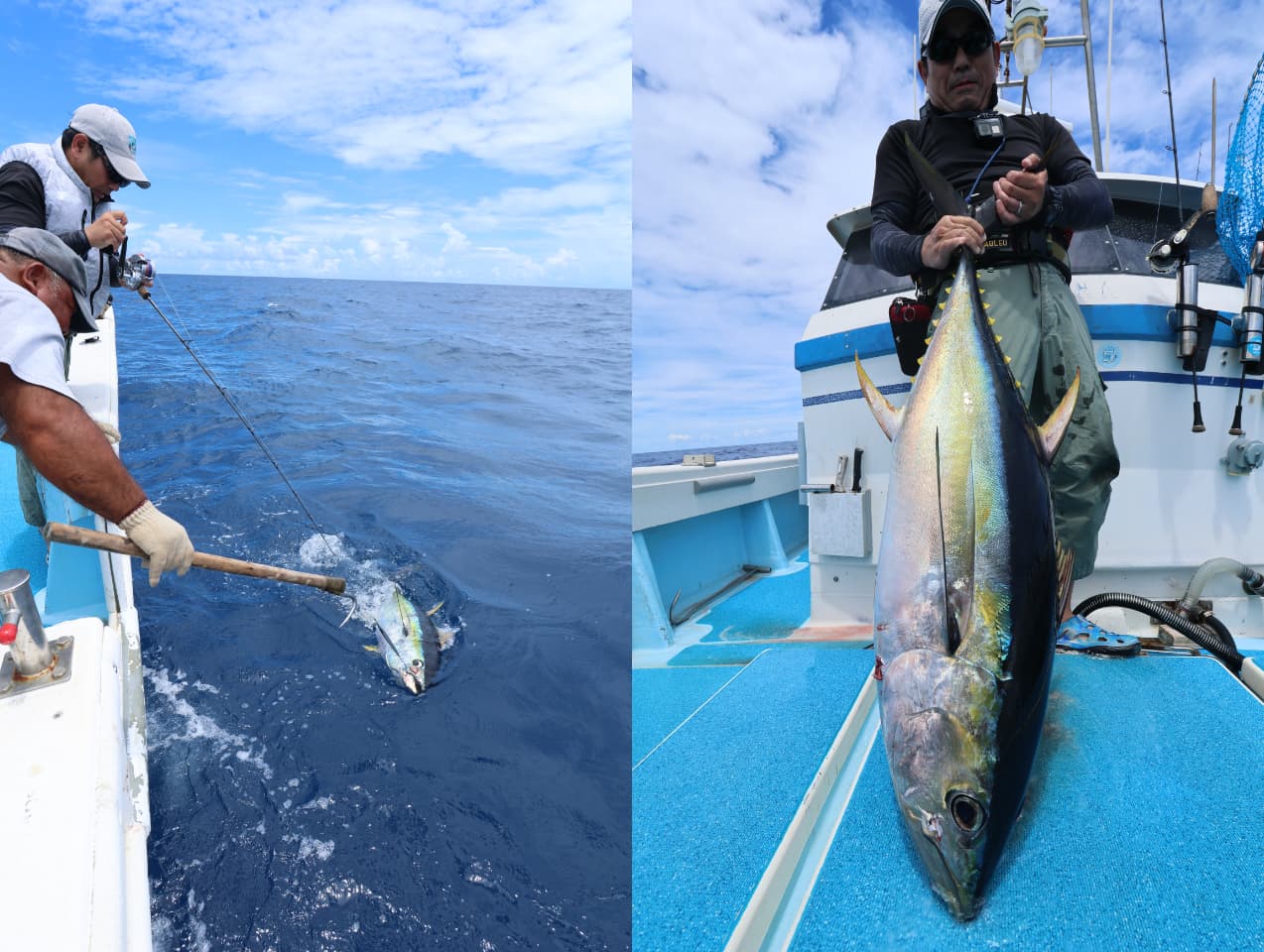
The first hit was by Mr Matsui of Takami Technos. He caught a good-sized fish without difficulty with a fight he was accustomed to.

The next jigging hit was by Mr Otsuka of Studio Ocean Mark. He is one of the pioneers of slow pitch jerk jigging for yellowfin tuna on Kumejima Island. He borrowed a SHIOU from Mr Ono and caught a solid fish.

This time, we were also testing rods. I got the impression that it looks pretty good for Kumejima yellowfin. We will introduce this one in more detail at another time.
On the second day, the atmosphere was more yellowfin than on the first day. When we arrived at Payao, good-sized yellowfin were bouncing around. Mr Otsuka, who had brought in casting tackle, immediately attacked by casting. Mr Ono, meanwhile, dropped a jig at the dana directed by the captain and skillfully manipulated the jig’s movement as he searched for the fish. First, Mr Otsuka’s plug was hit. The fish was a good size, weighing about 25 kg. After a while, Mr Ono also had a long-awaited hit. This one was a slightly prettier size weighing just under 20 kg. Later, Mr Ono was hit again on the fall of his jig. After some careful fishing, he landed a good-sized fish weighing 30 kg. He was satisfied with the size of the fish as well as the fact that his jig worked well.
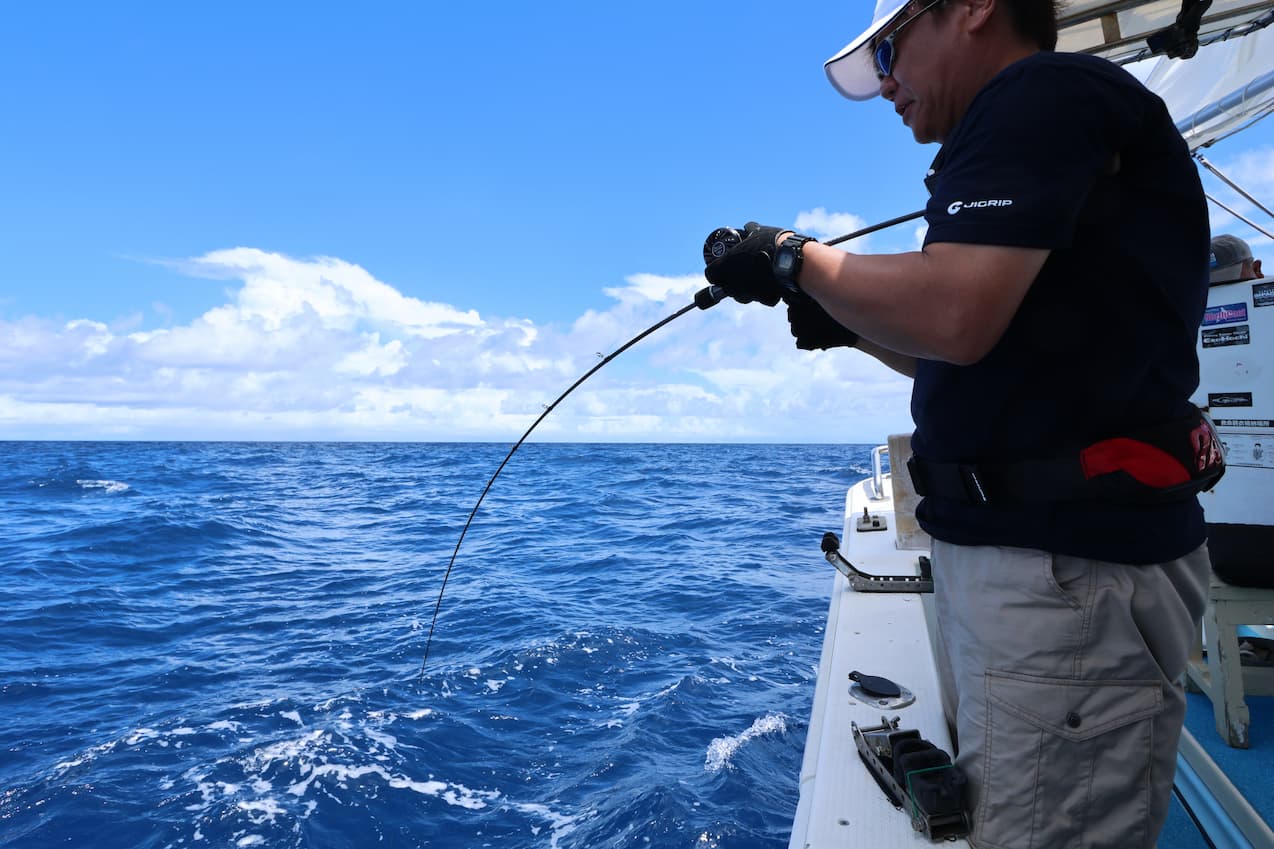
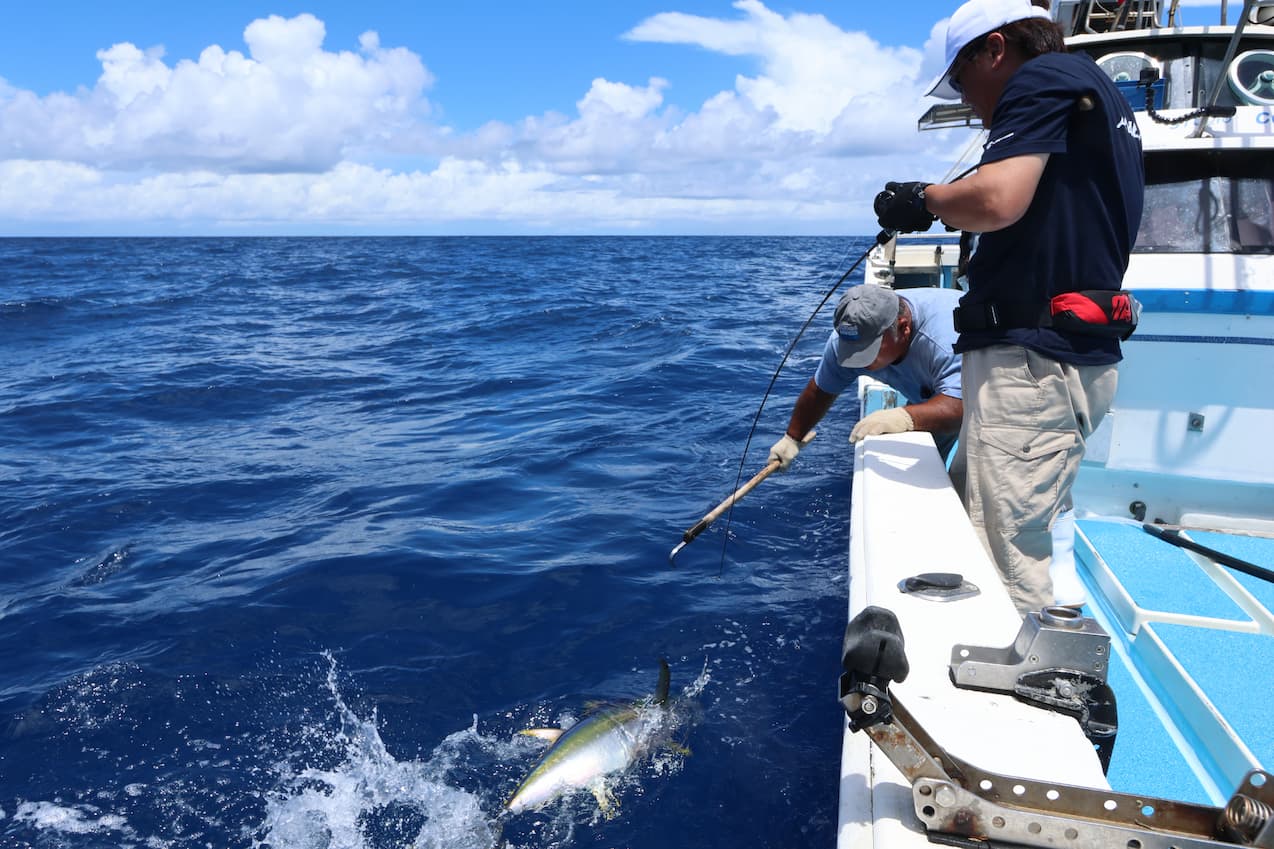
Mr Ono’s first hit, with the SHIOU working well.
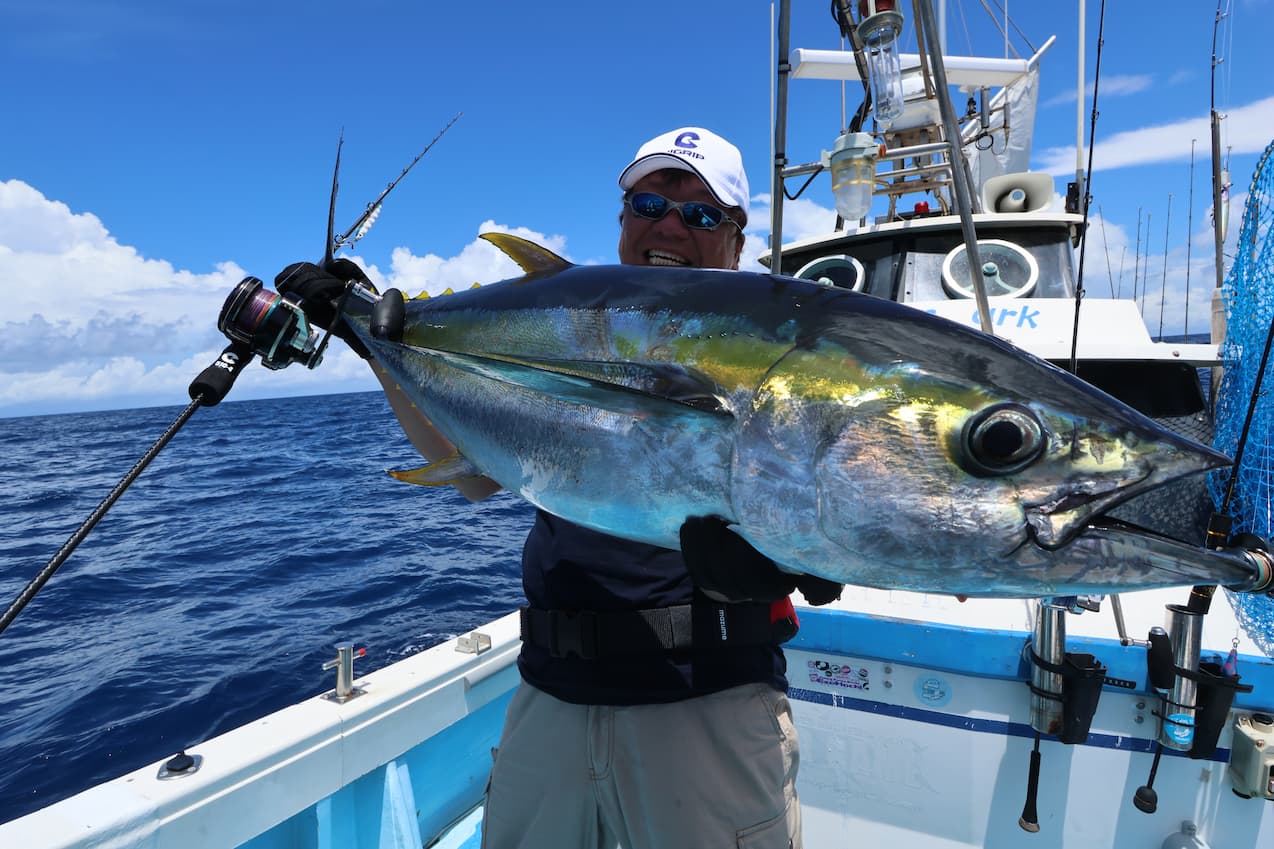
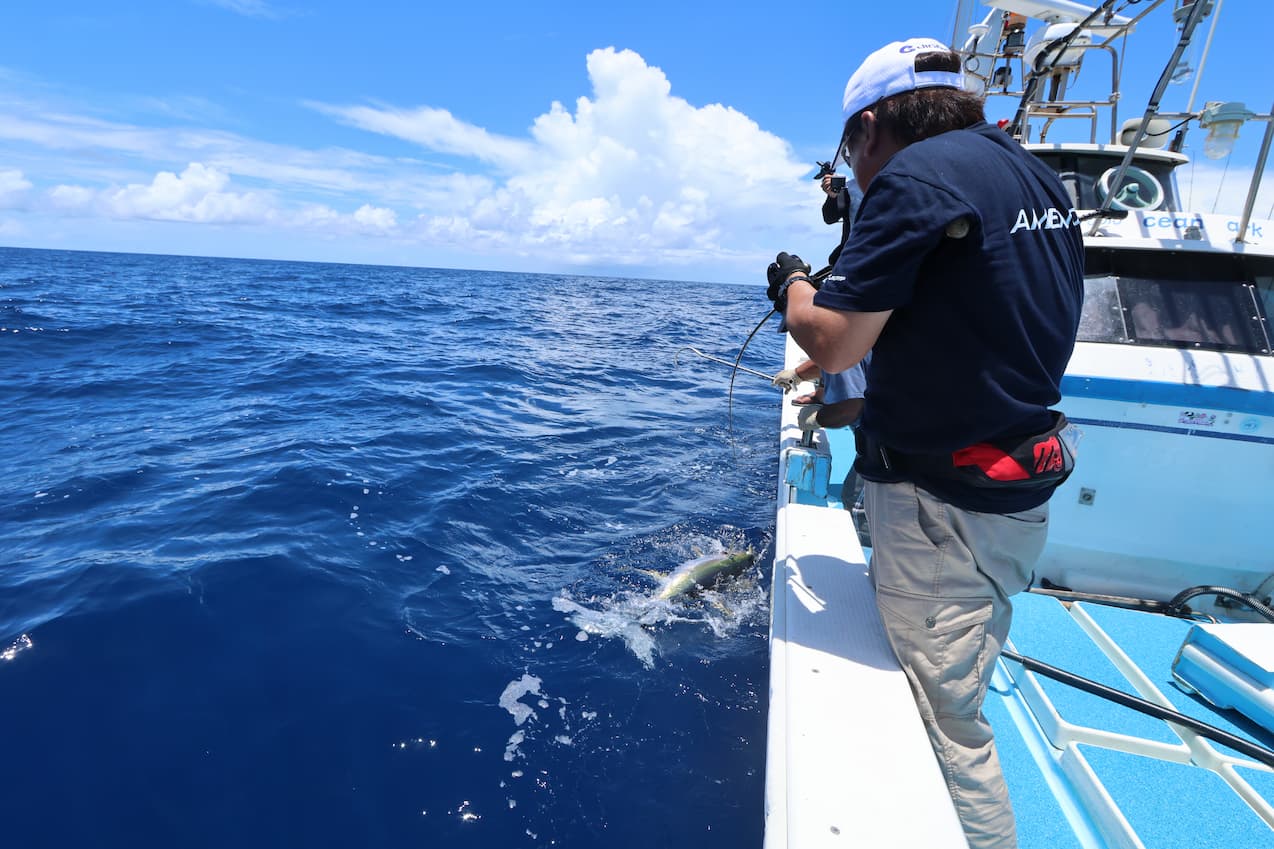

The next hit was a good-sized fish. Mr Ono was jigging and Mr Otsuka on the left was casting for a double hit. Yellowfin tuna on the surface were active throughout the day. Jigging, on the other hand, seemed to be a little less active.
On the third and final day, Mr Ono’s SHIOU did its job well. He got the first hit on the boat and caught a good size fish weighing over 30 kg. After that, another angler on the same boat caught two good-sized yellowfin tuna by casting, and everyone finished with a hit. Mr Ono was able to fully confirm the performance of SHIOU’s first prototype on this fishing trip.

Mr Ono was in great form on the third day! Bending the rod to apply pressure. The rod under test is a slow pitch jerk rod, but can be bent firmly as shown in the photo. We are looking forward to the release of this rod as well.
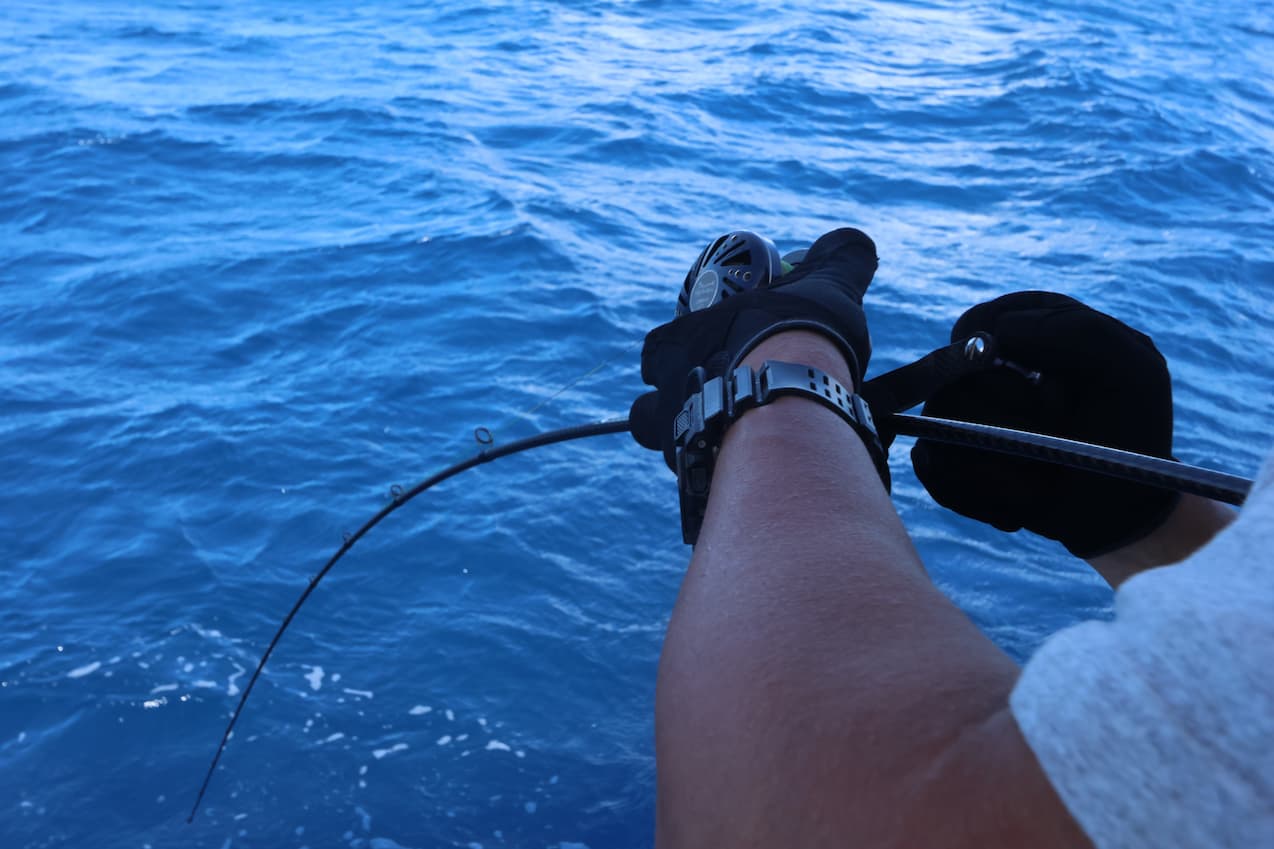
It is best to use a lever drag reel and adjust the drag while pulling in. After a hit, let it run at first, then stop and turn to reeling it in. If the fish repeatedly reels in and out at a certain level, add a little drag. For tips on how to fish, refer to the Kumejima fishing trip on the official JIGRIP YouTube channel below.
Kumejima Yellowfin Jigging Expedition Fishing Part 1
Aiming for yellowfin tuna with the proto jig SHIOU.
Kumejima yellowfin tuna jigging expedition Part 2
Do you know two tips to make tuna float?
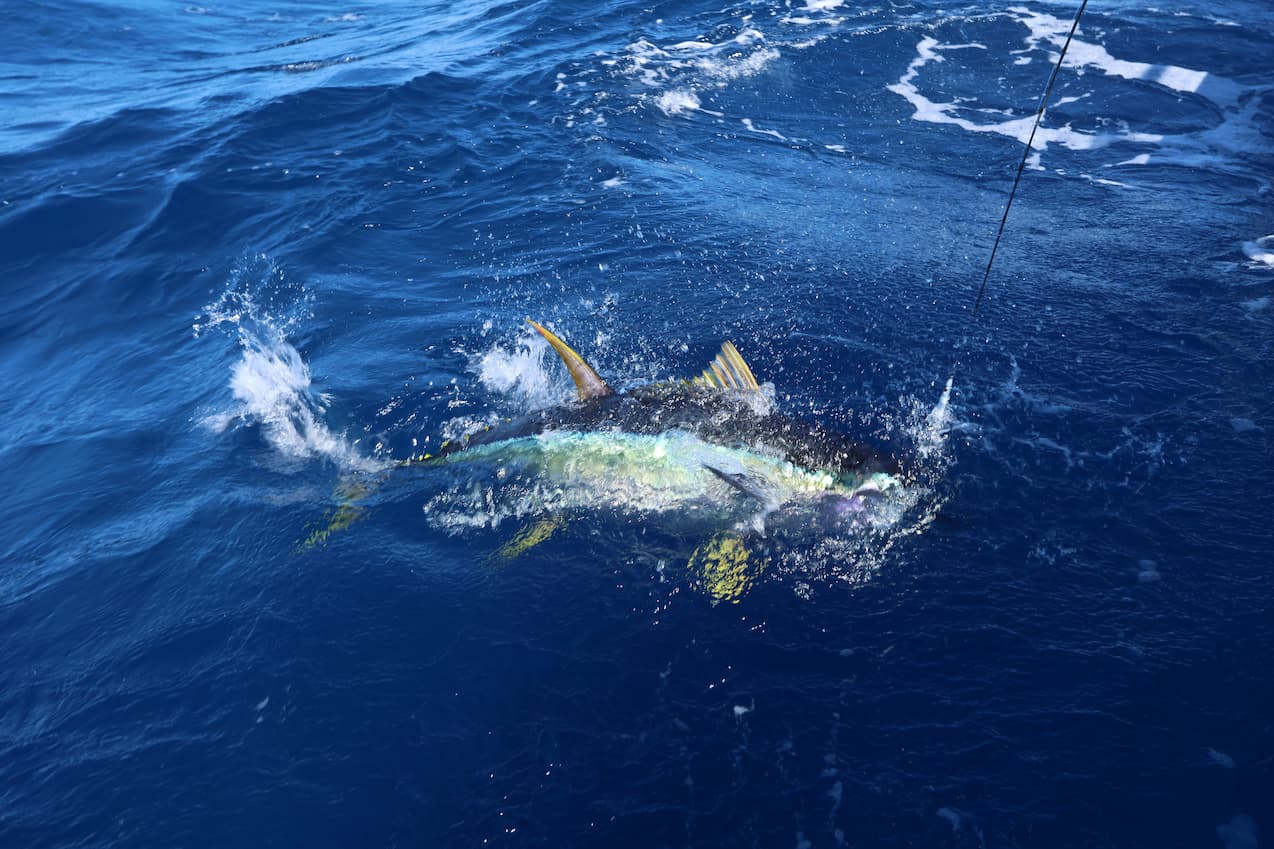
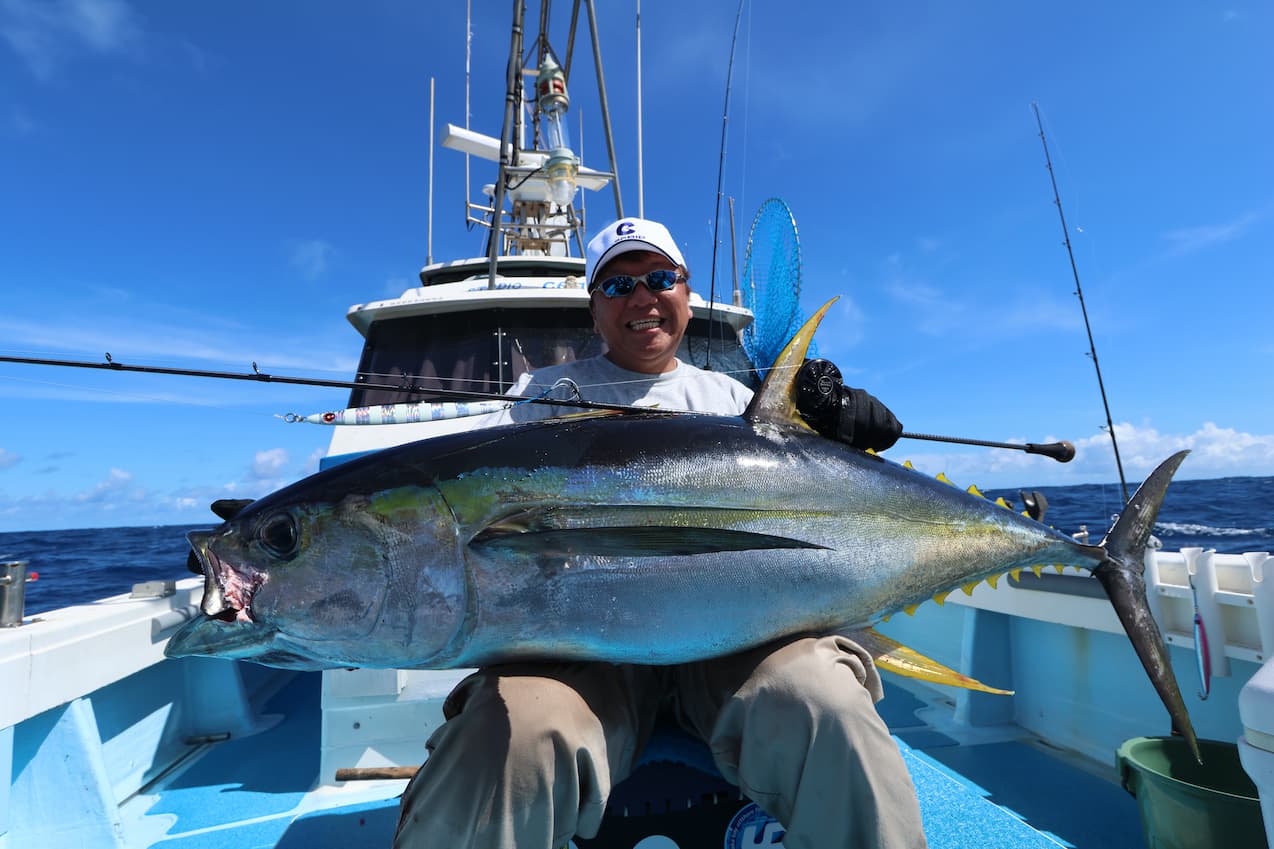
A satisfying 30 kg class was caught, fully confirming the performance of the SHIOU. After this, adjustments will be repeated to make it an easy-to-use jig that anyone can fish with.
The SHIOU line-up
After the Kume-jima fishing trip, Mr Ono made prototypes of each size to be used for various bluefish jigging while continuing to improve the SHIOU. He has been repeating tests on what he can do. As a result, the SHIOU line-up is planned to include 120g, 150g, 180g, 220g, 260g and 300g. This line-up will cover a wide range of fish, from light yellowtail, warasa and Spanish mackerel in coastal waters, to yellowtail in sunfish and tachi fish patterns, and kampachi and yellowfin tuna on expeditions. The product is scheduled to go on sale around March 2025. Mr Ono, who has created numerous jigs in the past, has created the SHIOU in pursuit of a jig that is easy for anyone to handle and leads to better fishing results.
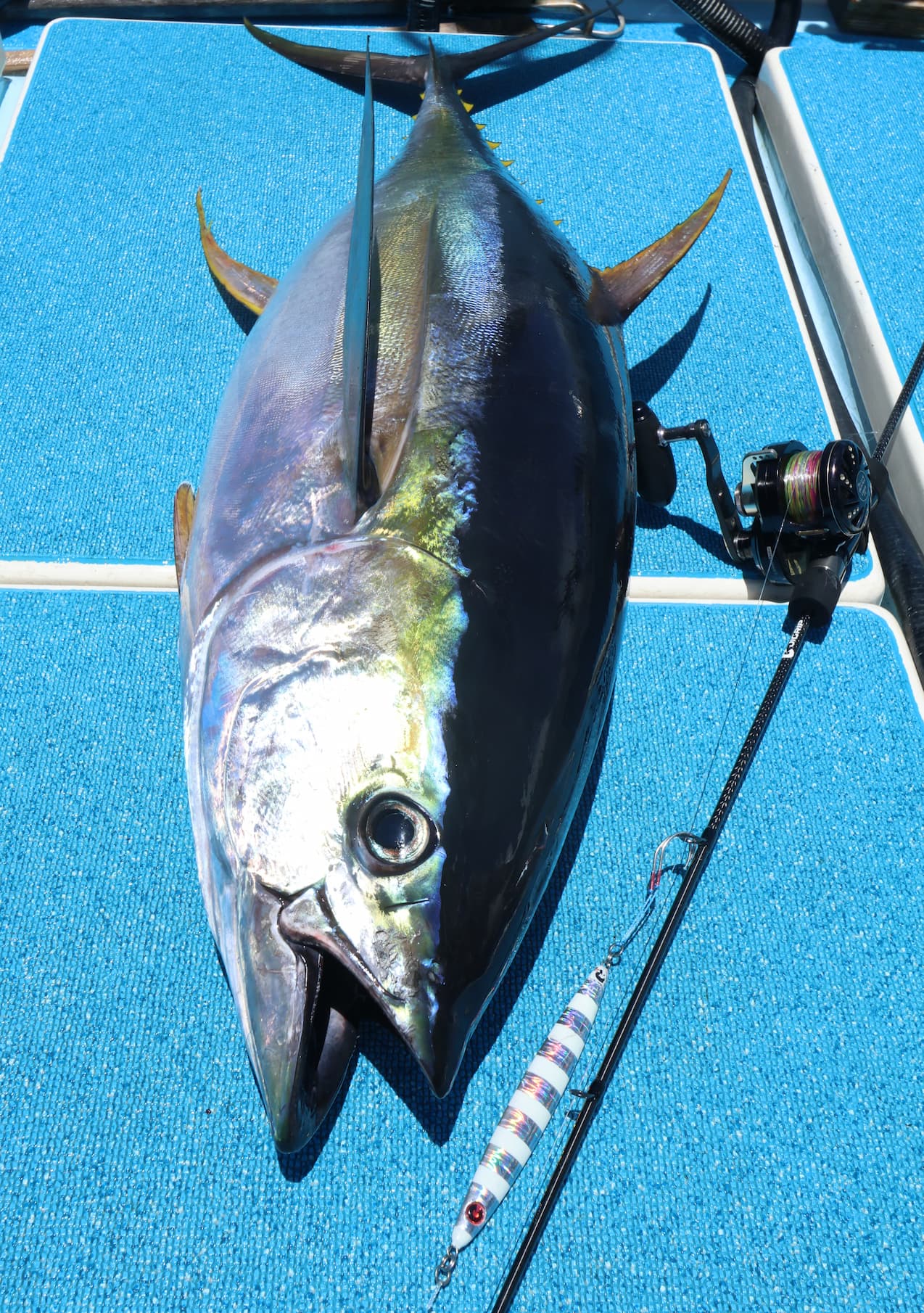

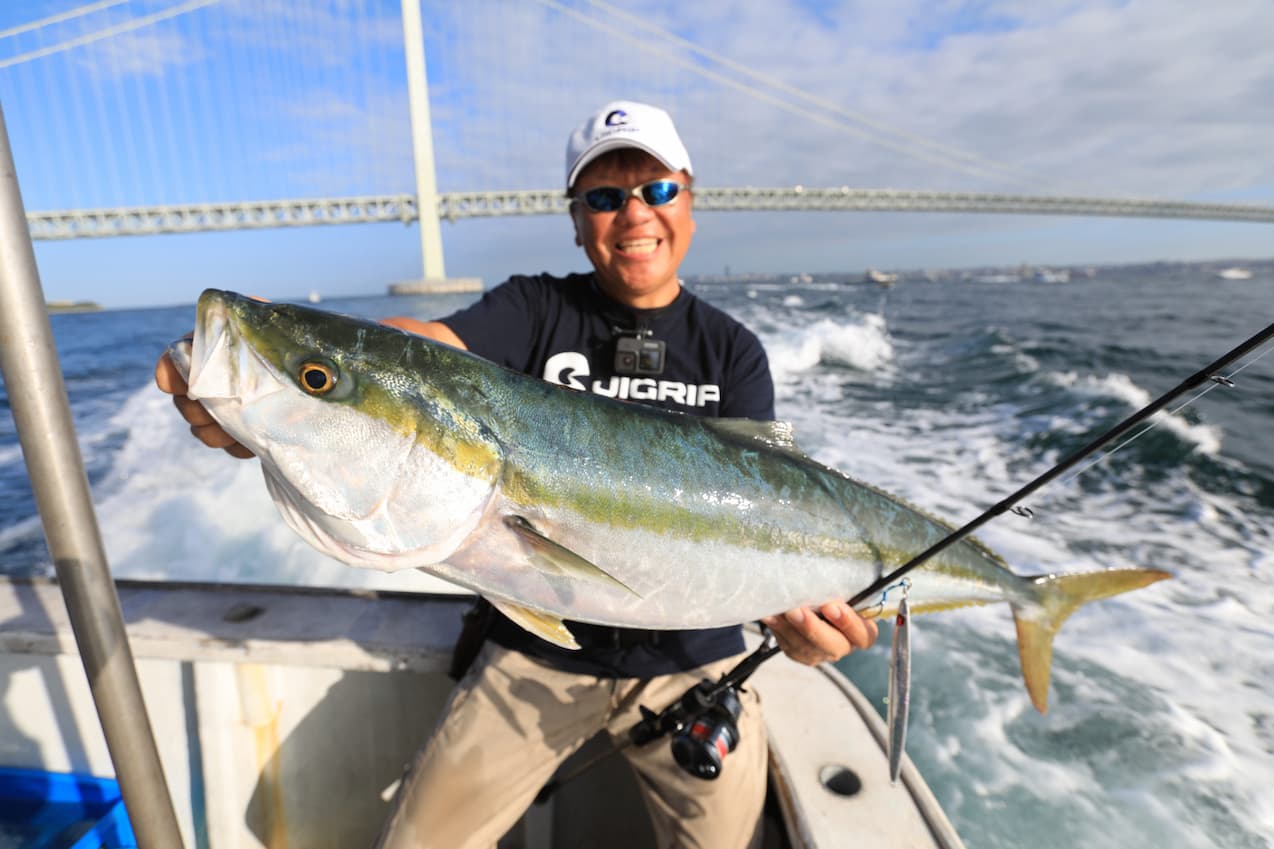
Prototypes of other sizes of the SHIOU are also being steadily produced. And tests are being repeated. We would like to introduce effective methods of operation with other fish in addition to yellowfin in due course.
We are constantly posting about JIGRIP products on Instagram and Facebook. Please check it out.
https://www.instagram.com/jigrip.jp/
https://www.facebook.com/profile.php?id=61558015262075


